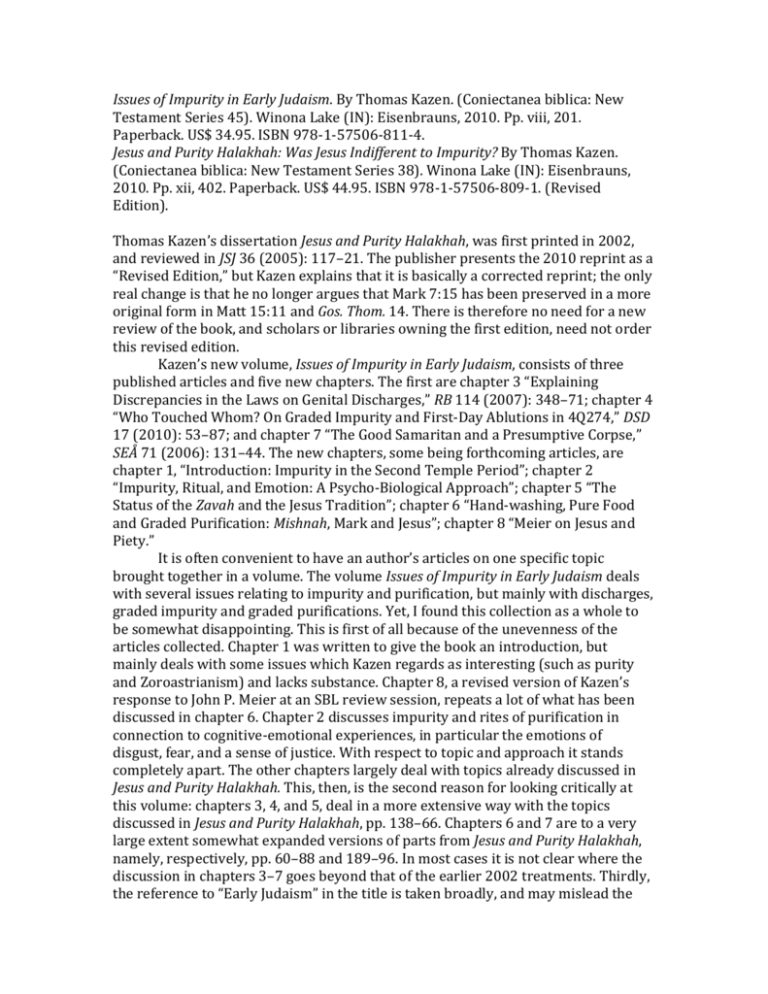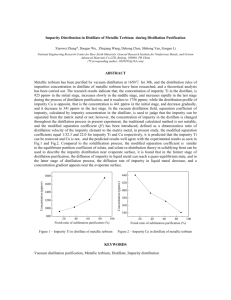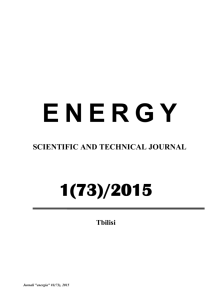View/Open
advertisement

Issues of Impurity in Early Judaism. By Thomas Kazen. (Coniectanea biblica: New Testament Series 45). Winona Lake (IN): Eisenbrauns, 2010. Pp. viii, 201. Paperback. US$ 34.95. ISBN 978-1-57506-811-4. Jesus and Purity Halakhah: Was Jesus Indifferent to Impurity? By Thomas Kazen. (Coniectanea biblica: New Testament Series 38). Winona Lake (IN): Eisenbrauns, 2010. Pp. xii, 402. Paperback. US$ 44.95. ISBN 978-1-57506-809-1. (Revised Edition). Thomas Kazen’s dissertation Jesus and Purity Halakhah, was first printed in 2002, and reviewed in JSJ 36 (2005): 117–21. The publisher presents the 2010 reprint as a “Revised Edition,” but Kazen explains that it is basically a corrected reprint; the only real change is that he no longer argues that Mark 7:15 has been preserved in a more original form in Matt 15:11 and Gos. Thom. 14. There is therefore no need for a new review of the book, and scholars or libraries owning the first edition, need not order this revised edition. Kazen’s new volume, Issues of Impurity in Early Judaism, consists of three published articles and five new chapters. The first are chapter 3 “Explaining Discrepancies in the Laws on Genital Discharges,” RB 114 (2007): 348–71; chapter 4 “Who Touched Whom? On Graded Impurity and First-Day Ablutions in 4Q274,” DSD 17 (2010): 53–87; and chapter 7 “The Good Samaritan and a Presumptive Corpse,” SEÅ 71 (2006): 131–44. The new chapters, some being forthcoming articles, are chapter 1, “Introduction: Impurity in the Second Temple Period”; chapter 2 “Impurity, Ritual, and Emotion: A Psycho-Biological Approach”; chapter 5 “The Status of the Zavah and the Jesus Tradition”; chapter 6 “Hand-washing, Pure Food and Graded Purification: Mishnah, Mark and Jesus”; chapter 8 “Meier on Jesus and Piety.” It is often convenient to have an author’s articles on one specific topic brought together in a volume. The volume Issues of Impurity in Early Judaism deals with several issues relating to impurity and purification, but mainly with discharges, graded impurity and graded purifications. Yet, I found this collection as a whole to be somewhat disappointing. This is first of all because of the unevenness of the articles collected. Chapter 1 was written to give the book an introduction, but mainly deals with some issues which Kazen regards as interesting (such as purity and Zoroastrianism) and lacks substance. Chapter 8, a revised version of Kazen’s response to John P. Meier at an SBL review session, repeats a lot of what has been discussed in chapter 6. Chapter 2 discusses impurity and rites of purification in connection to cognitive-emotional experiences, in particular the emotions of disgust, fear, and a sense of justice. With respect to topic and approach it stands completely apart. The other chapters largely deal with topics already discussed in Jesus and Purity Halakhah. This, then, is the second reason for looking critically at this volume: chapters 3, 4, and 5, deal in a more extensive way with the topics discussed in Jesus and Purity Halakhah, pp. 138–66. Chapters 6 and 7 are to a very large extent somewhat expanded versions of parts from Jesus and Purity Halakhah, namely, respectively, pp. 60–88 and 189–96. In most cases it is not clear where the discussion in chapters 3–7 goes beyond that of the earlier 2002 treatments. Thirdly, the reference to “Early Judaism” in the title is taken broadly, and may mislead the prospective reader: apart from chapter 4 on the Dead Sea Scrolls, the book deals largely with Hebrew Bible, New Testament, and Rabbinic Literature and rarely with specifically Early Jewish sources. It thus appears that Issues of Impurity in Early Judaism has two new contributions to make when compared to Jesus and Purity Halakhah. First, the chapters that rework parts of Jesus and Purity Halakhah are updated, containing references to and some discussions with more recent literature. Second, chapter two proposes a psycho-biological approach to the issue of impurity. It should be added, though, that apart from some references in other chapters to the feeling of disgust, there is no influence of this chapter on the rest of the book. For me, this second chapter was too impressionistic, jumping easily from emotions to Hebrew words and texts, and to issues related to impurity or purification. One such example is the association of the “sense of justice” with rites involving the act of kipper, which in itself is not exclusively related to rites of purification from impurities. Overall, this chapter needs more substantiation for it to become convincing. To end with a positive note: Issues of Impurity in Early Judaism is more accessible than Jesus and Purity Halakhah and it contains some chapters (in particular 5, 6, and 7) that can serve well to introduce intermediate students of the New Testament to some of the Early Jewish purity issues that are at the background of the gospels. Eibert Tigchelaar











